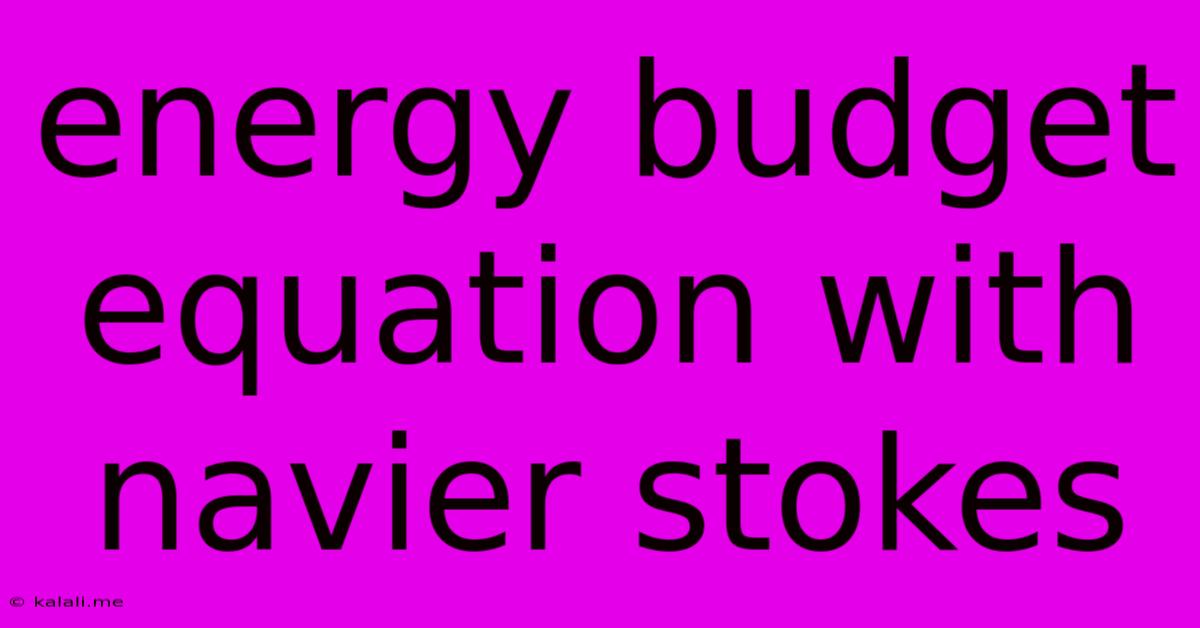Energy Budget Equation With Navier Stokes
Kalali
Jun 06, 2025 · 3 min read

Table of Contents
Energy Budget Equation with Navier-Stokes: A Deep Dive
The Navier-Stokes equations are a cornerstone of fluid dynamics, describing the motion of viscous fluids. Understanding the energy budget within these flows is crucial for numerous applications, from weather forecasting to designing efficient aircraft. This article delves into the derivation and interpretation of the energy budget equation derived from the Navier-Stokes equations, exploring its implications and practical significance. We'll unpack the terms, discuss their physical meaning, and highlight the key role they play in understanding fluid behavior.
Deriving the Energy Equation from Navier-Stokes
The energy equation arises from taking the dot product of the Navier-Stokes momentum equation with the velocity vector itself. This seemingly simple manipulation reveals a powerful statement about the energy balance within the fluid. Let's break it down:
The incompressible Navier-Stokes equation (ignoring body forces for simplicity) is:
ρ(∂u/∂t + u ⋅ ∇u) = -∇p + μ∇²u
where:
- ρ is the fluid density
- u is the velocity vector
- p is the pressure
- μ is the dynamic viscosity
- t is time
Taking the dot product with u:
ρ(u ⋅ ∂u/∂t + u ⋅ u ⋅ ∇u) = -u ⋅ ∇p + μu ⋅ ∇²u
This equation can be manipulated using vector calculus identities and the continuity equation (∇⋅u = 0 for incompressible flow) to yield the energy budget equation in a more interpretable form:
ρ(∂/∂t (1/2u² ) + ∇ ⋅ (1/2u²u)) = -∇ ⋅ (pu) + μ∇ ⋅ (u ⋅ ∇u) - μ∇u : ∇u
Understanding the Terms in the Energy Budget Equation
Let's analyze each term in the derived equation:
-
ρ(∂/∂t (1/2u² )): This represents the local rate of change of kinetic energy per unit volume. It describes how the kinetic energy at a specific point changes over time.
-
ρ∇ ⋅ (1/2u²u**))**: This term represents the convective transport of kinetic energy. It accounts for the movement of kinetic energy from one location to another due to the fluid flow itself.
-
-∇ ⋅ (pu**))**: This is the work done by pressure forces. It represents the transfer of energy due to pressure gradients. Regions of high pressure can act as sources of kinetic energy, while low-pressure regions act as sinks.
-
μ∇ ⋅ (u ⋅ ∇u)): This term relates to the viscous transport of kinetic energy. It accounts for the redistribution of kinetic energy due to viscous stresses within the fluid.
-
-μ∇u : ∇u: This is the viscous dissipation term. This term is always negative, representing the irreversible conversion of kinetic energy into internal energy (heat) due to viscous friction. This is the key term responsible for energy loss in the system.
Implications and Applications
The energy budget equation provides critical insights into various fluid dynamics phenomena. For example:
- Turbulence: The viscous dissipation term plays a dominant role in turbulent flows, where kinetic energy is constantly being transferred from large to smaller scales and ultimately dissipated as heat.
- Boundary Layer Flows: The interplay between pressure work and viscous dissipation is crucial in understanding the behavior of boundary layers, where the fluid velocity changes rapidly near a solid surface.
- Heat Transfer: The viscous dissipation term directly contributes to the generation of heat within the fluid, affecting the overall temperature distribution.
Conclusion
The energy budget equation derived from the Navier-Stokes equations provides a powerful framework for understanding the energy transformations within fluid flows. By carefully analyzing each term, we can gain invaluable insights into the complex interplay of forces and energy transfers that govern fluid behavior. This equation is fundamental to numerous applications in engineering, meteorology, and other scientific disciplines. Further exploration into specific applications and advanced techniques for solving the equation can lead to a deeper understanding of complex fluid phenomena.
Latest Posts
Latest Posts
-
Wiring A Ceiling Fan Blue Wire
Jun 07, 2025
-
E1 Heating To Print Temp Marlin
Jun 07, 2025
-
Hot Water Not Getting Hot Enough
Jun 07, 2025
-
Should I Both Brine And Marinate
Jun 07, 2025
-
How To Clean Jets In A Tub
Jun 07, 2025
Related Post
Thank you for visiting our website which covers about Energy Budget Equation With Navier Stokes . We hope the information provided has been useful to you. Feel free to contact us if you have any questions or need further assistance. See you next time and don't miss to bookmark.